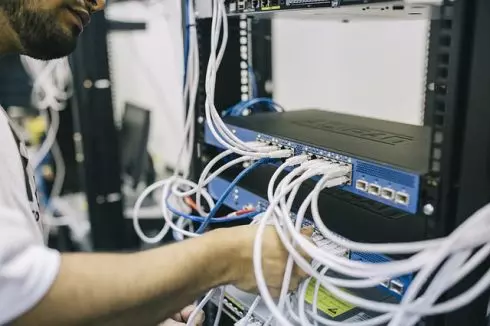
The increasing complexity of today’s networks continues to change the role of the network engineer. A recent survey from NetBrain, 2017 State of the Network Engineer, explores the many areas where the role is evolving and where network engineers are likely to face challenges in the coming years. With growing investments in security, cloud computing, and software-defined networking (SDN), agile network operations are a must. The study examined critical issues organizations are facing and we look to interpret them and their impact on both the network engineer and the enterprise in this article.
Towards greater automation and programmability
The most pressing issue is the fact that networks are growing rapidly and becoming far more complex than ever. Think about how many devices you have acquired over the past few years—cell phones, laptops, tablets, and PCs. Now imagine all the devices like switches, routers, and firewalls that make up an organization’s network infrastructure. You probably can’t! In our survey, 49 percent of enterprises with over 1,000 employees said they have more than 1,000 network devices, while 21 percent have more than 10,000 network devices. More critically, 83 percent of organizations surveyed indicated that the size of their networks has increased in the past year.
As networks continue to grow, engineers are realizing that that traditional network management methods are no longer sufficient to support their initiatives. Out-of-date manual processes for network troubleshooting, change management and cybersecurity can no longer keep pace with increased demand. To combat this, nearly 30 percent of survey respondents indicate that they plan to invest in network automation capabilities to alleviate many of the tedious tasks currently required of engineers.
In addition to the challenges of manual workflow, network engineers are forced to adapt to the evolving network by acquiring new skills. According to the survey, 53 percent of network engineers said they are required to know programming platforms like Python and Perl for their jobs—as they embrace a culture of DevOps and in support of automation initiatives—skills that were not requisites just a few years ago.
Growing importance of end-to-end network visibility
Another noteworthy challenge is the lack of visibility engineers have into their networks, especially as enterprises shift from physical networks to virtual and SDN environments. Documentation is one of the network engineer’s most important assets, but the ability of static documentation to keep pace with an evolving network is an issue that nearly every organization struggles with. In fact, 87 percent of survey respondents continue to rely on manual techniques to create and update network diagrams whether it’s through programs like Microsoft Visio or solely relying on the organization’s network experts.
Due to the complex nature of today’s networks, generating network diagrams manually takes far too long. This leads to slower troubleshooting, prolonged security impacts, or lack of compliance. In fact, 49 percent of respondents cited the time it takes to create network diagrams as a primary challenge, and 33 percent said it would take more than one month to document their entire network manually.
Because of the length of time it can take to document a network, engineers also cited obsolescence as a challenge. Fifty eight percent of network engineers said that network diagrams become obsolete as soon as the network changes. Additionally, 61 percent of survey respondents said that up to half of their network documentation is out of date, with 44 percent of respondents indicating that it’s been more than one month since they last updated their network diagrams.
From tribal knowledge to greater cross-IT collaboration
Many of today’s network engineers still rely on “tribal” knowledge as a key way of managing network problems. This means many organizations are still relying on a single network engineer’s knowledge of the network to help troubleshoot advanced network issues or respond to cyberthreats. This reliance results in decreased efficiency and slower resolution time when an issue does arise. In fact, 33 percent of survey respondents identified this over-reliance as a key obstacle.
However, the overarching issue is often lack of collaboration, not only among network engineers, but with peer IT teams as well, primarily the security and application groups. Forty-five percent of network engineers surveyed cited a lack of coordination between IT teams as the number one challenge for more effective troubleshooting while 57 percent of respondents cited the inability to codify and share best practices as hampering more effective troubleshooting, particularly when it comes to responding to cyberattacks.
Continuously securing the network rises to the top
Network security is a major area given the constant nature of threats today. When faced with an attack, it is imperative that network and security teams act quickly to isolate and mitigate the risk, and then work together to share best practices to minimize future threats. Network security would be at particularly great risk if too much time is wasted identifying and searching for the organization’s expert to get the job done. That’s why 72 percent of respondents said that the lack of collaboration across network and security teams was the number one challenge when troubleshooting security issues.
Moreover, our survey revealed just how top of mind network security is to organizations. For instance, 64 percent plan to invest in network security within the next 12 to 24 months. More critically, nearly 50 percent of respondents cited that today, the inability to continuously monitor and mitigate attacks without human intervention is a significant gap in IT. With this heightened focus, the evolution of continuous network security will grow into a key paradigm. With automation as the technology linchpin, the future will be one where the benefits of continuous network hardening, isolation, and mitigation will be delivered through a seamlessly integrated and machine-to-machine triggered IT ecosystem.
In short, it is fair to say that the past few years have represented a major shift in the role and qualifications of the network engineer. Networks have become far faster and more powerful, but they also have become more bloated and complex. The shift to virtual infrastructures, cloud computing, and SDN will only accelerate this trend. Automation represents the best defense against complexity as it removes tedious tasks from network engineers, devotes more time and resources to critical applications, and advances the organization toward a world of agile network operations. Change is coming, the only question is whether your organization will be prepared to deal with it.








